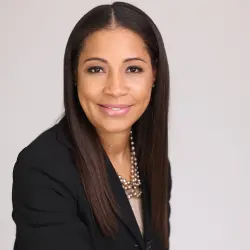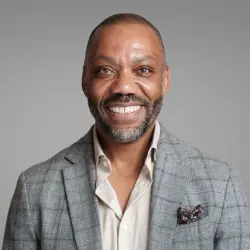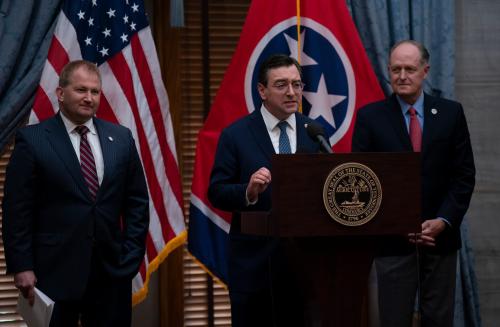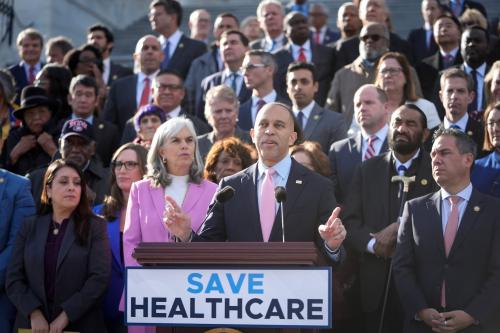A lot of these legal implications of removing DEI, I see it as robbing people of the resources that they deserve. And so for me, I’m going to always show that resource deprivation has an impact, but I’m also going to show that we have seen significant growth over the last hundred years.
Andre Perry
In this first episode of Metro Blueprint, experts discuss how efforts to weaken DEI protections result in taking away resources from people who deserve them. Andre Perry, a senior fellow at Brookings Metro and director of its Center for Community Uplift, along with Stacy Hawkins, a professor at Rutgers Law School and a Brookings nonresident senior fellow, explain how Black Americans can still achieve economic growth despite these efforts.
- Listen to Metro Blueprint on Apple, Spotify, or wherever you like to get podcasts.
- Watch episodes on YouTube.
- Learn about other Brookings podcasts from the Brookings Podcast Network.
- Sign up for the podcasts newsletter for occasional updates on featured episodes and new shows.
- Send feedback email to [email protected].
Transcript
[“doors opening”; music]
PUENTES: Hi, I’m Robert Puentes, vice president and director of Brookings Metro. I’m also the host of Metro Blueprint, a new podcast from the Brookings Podcast Network. Every two weeks a different Brookings Metro scholar and a guest will discuss ideas and action to create more prosperous, just, and resilient communities in America.
Our scholars and their guests will discuss specific research findings and policy actions to improve the well-being of people and their communities. Topics will include economic and workforce development, climate and the built environment, changing demographics, place-based policymaking, the future of work in the age of Artificial Intelligence, and much, much more.
How much legal power does President Trump have in enforcing his executive orders targeting diversity, equity, and inclusion efforts and LGBTQIA protections? In the first episode of Metro Blueprint, Andre Perry, senior fellow at Brookings Metro and director of our Center for Community Uplift, along with Stacy Hawkins, a professor of Law at Rutgers Law School and a Brookings nonresident senior fellow, discuss how, despite efforts to weaken policies that encourage equity, protections against discrimination under federal civil rights law remain in the hands of federal courts and not President Trump.
[music]
You can learn more about this podcast on our website, Brookings dot edu slash Metro Blueprint. And now, here’s Andre and Stacy.
PERRY: Thank you, Rob.
Hello, my name is Andre Perry. I’m a senior fellow at the Brookings Institution where I research issues of economic security and well-being across race and place in the United States. We are now in a time when our nation has made significant strides in elevating the voices and power of historically disenfranchised racial groups, including Black, Latino, and Asian communities, as well as LGBTQIA populations. However, many of the tools, such as diversity, equity, and inclusion initiatives, DEI, that have been used to increase participation in mainstream institutions and capital flows are under attack.
In this episode, Stacey Hawkins, a professor of law at Rutgers Law School and a nonresident senior fellow at Brookings Metro, and I will discuss the recent flurry of executive orders President Trump has signed that seek to weaken DEI and LGBTQIA protections. Among the dozens of such orders that President Trump signed in his first few days in office are one ending DEI efforts in the federal sector, another directed to eliminate DEI efforts across non-federal entities that receive or manage federal awards, and a third that targeted protections for LGBTQIA individuals.
Stacey, I’m so glad you’re here with me in the studio as we unpack many of the questions surrounding the impact of these executive orders across three key areas: the federal workforce, private employment, and higher education.
HAWKINS: Thank you so much, Andre, for having me. It is both a pleasure to be in conversation with you and it is a privilege to be a guest on your show.
PERRY: Very good, let’s get at it. The Trump administration’s executive orders characterized DEI efforts as a violation of civil rights law and discriminatory in nature. What do you make of this argument?
[3:48]
HAWKINS: Well, one of the things, Andre, that’s clear if you parse the language of the executive orders, as well as in the particular details of some of the guidance that’s come out of the executive agencies after the executive orders, is that there is a clear acknowledgement that not all DEI efforts are per se unlawful. There’s an important distinction that is made, especially in the guidance, between those DEI efforts that constitute racial or gender preferences or DEI efforts that segregate individuals on the basis of their group identity and other types of DEI efforts. And only the former are really targeted as unlawful.
And so I think that if you drill down on what the Trump administration has released in terms of clarifying guidance about the executive orders, it’s pretty clear that they don’t consider all DEI efforts unlawful. They’re targeting a certain set of DEI efforts.
But it’s clear that they’re designed to have a chilling effect across the board. And so I do think that we have to pay attention to the ways in which companies are responding and in particular over responding to those executive orders. But they have a much narrower focus than people might think.
PERRY: So, a lot of the DEI efforts are not illegal, but it is having a chilling effect. How are you advising these groups and just characterize the impact of these executive orders on behavior in everyday life.
[5:17]
HAWKINS: So the first thing to be clear about is that the executive orders do not have the force of law. They don’t regulate private individuals’ behavior. They simply direct the enforcement efforts of the executive agencies under Trump’s control. And so really, it’s important for enterprises to pay attention to the legal landscape. And while that legal landscape is undoubtedly shifting as courts, including the Supreme Court, issue new decisions on these issues every day, it’s very clear that those decisions are not always aligned with how the Trump administration is interpreting civil rights law, and the broad prescriptions that they claim exist under those laws insofar as diversity, equity, and inclusion efforts are concerned.
And so I think that organizations really need to inform themselves about what the state of the law is, even if they’re targeted by the Trump administration for investigation or for, as some of the law firms have recently been targeted for, information about their diversity, equity and inclusion policies, they should not consider that tantamount to a decision about the unlawfulness.
Because again, that is a decision that’s going to be left to courts. And so far, the decisions that are coming out of courts do not condemn diversity efforts to the extent that the Trump administration has condemned them.
PERRY: Now, over the last four administrations, we’ve seen the use of executive order. And let’s just go back to Obama. He used executive orders quite a bit. Trump came in, and he went further. Then Biden came in and went further. And now we have Trump again. Just tell us about the nature of executive orders. You wrote a brilliant piece, an explainer on the Brookings platform—I want everyone to take a look at that piece—but can you just talk about the nature of executive orders and how they’ve been used over the last 20 years?
[7:08]
HAWKINS: Yeah, so as I said, they don’t have the force of law. Really what they represent are the president, or the chief executive of the federal agencies, policy directives to the agency branch officers about how to administer their enforcement authority. And so I explain, for instance, to my law students that the legislative branch, or Congress, they make the law, the executive branch enforces the law, and then the judicial branch interprets the law.
And so there are lots of statutes that have been passed, for instance, employment law statutes or the educational statutes, the Higher Education Act, that have enforcement authority under the executive branch, under agencies like the Equal Employment Opportunity Commission or the Department of Education. And Trump oversees those agencies, and those agencies enforce the law.
And what he’s doing with an executive order is directing those agencies how to use that enforcement power. It doesn’t change the law; the law has been enacted by Congress. And executive orders have no ability to change the actual law. They simply direct the federal agencies and the officers of the federal agencies how to exercise that enforcement power.
So for instance, Title VII is the federal law that controls workplace discrimination. And Title VII prohibits improper considerations of things like race or gender or religion in workplace decisions. One of the things that the Trump administration has directed the EEOC to do, and one of the things that the EEOC acting commissioner has said she will do, Andrea Lucas, is to exercise the enforcement power under Title VII to really protect people that have traditionally not been the subject of protection. So for instance, rather than using that enforcement power under Title VII to protect women and racial or gender minorities from discrimination, she has declared that she’s going to use that enforcement power to protect white males and cisgender individuals from discrimination.
Again, it’s all about discrimination on the basis of race, gender, national origin, or religion under Title VII. And yet the way in which that authority gets enforced varies. So of course we saw Biden and Obama enforce Title VII in ways that protected the rights of minorities, women, and LGBTQIA individuals. And the policy priority shifted under Trump. And I think that that’s always going to be the case. The pendulum swings back and forth depending on which party controls the White House and therefore sets the policy priorities and enforcement authority for the federal agencies.
PERRY: People are concerned that these executive orders have done irreparable harm to government. What are your feelings about what can be reversed or how are we gonna move forward whenever a new administration takes hold of office?
[9:48]
HAWKINS: So I think history has shown that this pendulum swings back and forth regularly between the transition of political administrations. And so, again, between the Obama administration and the first Trump administration, we saw the wholesale not necessarily dismantling like we’re seeing now, but certainly the kind of non-enforcement, the non-pursuit of all of the DEI initiatives that Obama had started. And I think similarly with respect to the transition from the first Trump administration to the Biden administration.
I think that we are capable of making these kinds of transitions. I do think that some of the administrative gutting structurally that Trump is doing, right? so closing the Department of Education and/or downsizing the staff, eliminating the kind of authority that is exercised and moving it to other agencies, I do think that that might be a little bit more difficult to undo.
I think that the fallout of these executive orders for private industry is much more, in my opinion, overblown. I do think that, yes, there are some private enterprises that are responding to the Trump administration’s executive orders by scaling back and or modifying some of their programs. But my understanding is that for the most part, these enterprises are trying to preserve as much as possible about what they’re doing, understanding that this is a long-term commitment for them, and this is short-term administration. And so I think that they’re taking steps that are easily reversible and/or that don’t really disrupt their long-term commitments to DEI.
I think that that’s true of the private sector, both in terms of business as well as in higher education. I do think that the gutting of the actual federal government structurally, in terms of their personnel resources and other enforcement resources, is probably going to be a long-term problem for the federal government.
[11:42]
PERRY: I might be an eternal optimist in this regard, but I actually see the data in business in particular. Black businesses have grown at least in terms of employer firms since 2017 through multiple administrations. We’ve seen an increase in the number of firms with more than one employee in Black, brown, and Asian communities. And what that tells me is that people know how to adjust. People move forward. Certainly, I think the actions of any administration have consequences, and we feel them in real time. But I also just have a lot of faith that people how to respond, particularly the descendants of the enslaved. Part of our legacy is moving forward in spite of policy.
At a city level, I work at Brookings Metro, and city procurement processes in which they pursue a diverse set of suppliers to deliver various goods and services on behalf of the cities that they’re in. There is a strident effort to make sure that all taxpaying citizens have access to their government services and opportunities. What should we look for in the next few years in terms of the municipal response to what they’re hearing at the federal level?
[13:17]
HAWKINS: So, as a constitutional law scholar, what I would say is a lot of the legal arguments that are being made around the inability to use race and to a lesser extent gender in decision-making processes has to do with the federal Constitution. And that constrains public actors—federal governments, state governments, municipal governments. And so to the extent that the Supreme Court has interpreted those prescriptions under the Constitution to prevent governments from using race in the consideration of decision-making processes, then that’s going to constrain municipal and state governments to the same extent it constrains federal governments.
But there are opportunities, again, to really respond to the inability to use race directly by thinking more creatively about how municipalities and other entities, actors, whether they’re public or private actors, achieve those objectives, which is to open up opportunities and to ensure inclusion, right? in their contracting or business or other programs and services. And I think that you can look at lots of ways to identify how to be more inclusive in your practices and your decision-making processes than using race and/or gender directly in your decision-making.
So, again, if you’re talking about government contracting, lots of those programs presume that the people who are outside of those opportunities are disadvantaged. And so they have historically been disadvantaged, and so one of the ways that we open up opportunities is that we target people that we think have been excluded, often on the basis of race and gender. If you’re no longer allowed to use race and gender to open up those opportunities, you can directly select for disadvantage. Who has been excluded from these opportunities in the past? Who’s never had one of these contracts? Who has never served in these municipal programs?
And so looking at people who have been excluded based on their individualized experiences rather than using their race and gender as a proxy for their exclusion, I think is a way for us to modify those programs to still achieve those goals.
PERRY: I’ve asked you a lot of questions. I wonder do you have any questions for me that I may respond to?
HAWKINS: Absolutely. I have long been a fan of your work, and I think it’s such important work, especially about the Black wealth gap. And I’m just curious with your book coming out, if you can talk about how Black Americans are continuing to build wealth under the new conditions with these executive orders and the new restrictions that don’t permit programs to directly target race.
[15:52]
PERRY: For me, in my book, Black Power Scorecard: Measuring the Racial Gap and What We Can Do to Close It, in that book, I’m very clear about what resources can do. Resources predict for behavior. One of my taglines in and around my work, I say that there’s nothing wrong with Black people that ending racism can’t solve. Many of the issues that we see in society are a result of discrimination, or a result a lack of intergenerational wealth transfer, or just a lack resources overall. And we know, and we see in the data, that there have been significant periods of time where Black people have not had access to basic public goods.
And so how do you close wealth gaps? I don’t know if we can necessarily close wealth gaps. But we can certainly enable people to have a quality of life that is related to the resources that we all receive.
But to be clear, we have a lot of citizens who deserve public goods. Either they need access to the opportunities they provide, they need the resources that they provide. We’re not gonna close the wealth gap by allowing a few private individuals and corporations to determine when it’s appropriate and who should receive these goods.
[17:15]
So for me, I know how we can grow wealth is by giving people assets that they deserve and removing the discrimination that gets in the way. So from a researcher’s point, it’s very clear. When people can own a home, when they get access to a government contract, when they get decent incomes, when they have a 401k, when they have insurance—guess what? They thrive.
And so for me, a lot of these legal implications of removing DEI, I see it as robbing people of the resources that they deserve. And so for me, I’m going to always show that resource deprivation has an impact, but I’m also going to show that we have seen significant growth over the, particularly over the last hundred years, that is a result of our cooperation, of our racial cooperation, of us understanding what discrimination does. As well as understanding what it means to restore the value that’s been extracted by racism.
So I’m not a legal scholar, I’m a policy person. So I know that I need to create policies that work for everyone. And I’m also clear—sometimes I get in trouble for this, the way I say it, I don’t know if it’s correct—but I’ve always said that DEI and affirmative action are not the goals. They were expedients toward the goal, intermediary steps towards the goal of concrete policy that works for everyone. And I could opine on this, but the use of executive order is by no means the same as legislation. And in my new book, I basically say we need the goals of legislation at the end of the day. And we need legislation that works for everyone.
[19:16]
HAWKINS: So, I’m wondering, you heard me say that the shifting legal landscape is increasingly preventing government actors in particular, who obviously dictate policy, from using race directly to select for or to distribute benefits or opportunities. But you say it’s not really racist about the resources. And so if policies, if programs, if the efforts of the government and others that are distributing these kinds of resources target the disadvantage itself, right? the lack of resources rather than targeting race, do you think that still has the potential to close the wealth gap, to close the resource gap? Because if what we really care about is getting resources to the people that don’t have resources, while that might significantly overlap with race and ethnicity, it’s not race and ethnicity. To your point, it’s not really about their race and ethnicity, it’s about their lack of resources.
[20:08]
PERRY: Right, and this is where I’m willing to give ground. I recognize that being Black is not a total proxy for being disadvantaged. And we have to look at the many factors that make someone disadvantaged. And so place, income, wealth, and other factors will make it more difficult to get the resources necessary to thrive.
With that said, I also think just like any other claim can be made with an injury, we should be able to make claims based upon injuries based on race. And so for me, I think we can do both at the same time, that we can figure out new definitions of being disadvantaged. And that’s just the American way to give everyone an opportunity to achieve the quote unquote “American Dream.” That should be who we are as a country.
In addition, it’s undeniable that people have intentionally denied resources to Black people. And there’s been injury to that. And there should be an ability to claim and get resources based upon that claim.
And so for me, I think we need to work on both. I think we can do both. We have the minds and the willingness to do both. But I do hear arguments that we have to do one or the other. And it’s like, no, we can walk and chew gum at the same time.
[21:42]
HAWKINS: Yeah, I’m in entire agreement with that, and I think it’s important to note that the law does provide some small leeway for using race only when it is specifically directed towards identified past discrimination. So to your point, if there are strong legal and evidentiary claims that can be made about how certain individuals have been specifically disadvantaged by their race, I think that those still have some potential for succeeding under the law, but it’s a very, very narrow path. And so I agree we have to do both. We have to be willing to take advantage of both of those arguments and marshal evidence against all of that.
PERRY: Well, I would just want to thank you, Stacy, for your thoughtful insights. This has been an illuminating conversation. I look forward to your future research and practice in the future.
[music]
You can learn about this topic and others by visiting Brooking dot edu slash Metro and by signing up our Center For Community Uplift Newsletter at Brooking dot edu slash newsletters. Thank you very much.
PUENTES: Metro Blueprint is a production of the Brookings Podcast network, found online at Brookings dot edu slash podcasts. Thank you for listening.
My thanks also to all the scholars and guests for sharing their insights and expertise, and to the team at Brookings that makes this podcast possible including Fred Dews, producer; Erin Raftery, associate producer; Gastón Reboredo, audio engineer; Daniel Morales, video editor; Leigh Balon, Brookings Metro’s director of communications; Carie Muscatello, our graphic design and web publishing manager; as well as our government affairs and promotion colleagues in the Office of Communications. Katie Merris designed the beautiful logo, and Phoebe Copeland recorded the doors audio.
For more information about us, please visit Brookings dot edu slash Metro.
I’m Robert Puentes.
The Brookings Institution is committed to quality, independence, and impact.
We are supported by a diverse array of funders. In line with our values and policies, each Brookings publication represents the sole views of its author(s).








Commentary
PodcastWhat are the economic and legal implications of President Trump’s DEI and LGBTQIA executive orders?
Listen on
Metro Blueprint
April 23, 2025